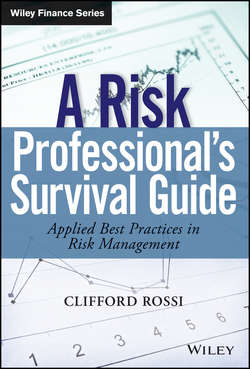Читать книгу A Risk Professional's Survival Guide - Rossi Clifford - Страница 5
На сайте Литреса книга снята с продажи.
Preface
ОглавлениеThe intent of this book is to provide the next generation of risk leaders, as well as current practitioners of financial risk management, a handy reference of techniques and concepts for identifying, measuring, and mitigating the major risks facing financial institutions. Risk management has evolved over the past decade into a highly quantitative field, drawing on increasingly complex mathematical and statistical concepts to portray a variety of traditional risks such as credit, counterparty, market, and interest rate risk. At the same time, the financial crisis of 2008–2009 laid bare the limitations of sophisticated quantitative analysis. Advances in quantitative risk management will continue; however, risk managers must be mindful of the “art” of risk management, namely judgment and experience that augments the “science” of risk management. Many risk management books focus on the quantitative aspects of the field rather than explore the importance of the qualitative side of risk management. This book is an attempt to bring both perspectives together in a cohesive fashion.
Another feature of this book is to provide readers with a framework for thinking about risk not as a singular outcome, but one that has consequences that may ripple across other parts of the business or risks. Leveraging experience from the crisis and afterward, the book follows the events of SifiBank, a stylized significantly important financial institution that provides the common thread of risk management practices throughout the course of the book. In that regard, this book represents a significant departure from other risk management books in that it is effectively a case study of one large complex commercial bank. To bring that story alive, a synthetic balance sheet is constructed within which specific positions, portfolios and loans are created. This information is then used in a series of Excel/VBA workbooks to provide the reader a hands on companion to the text discussion of key concepts and models.
The structure of the book starts by providing background on SifiBank, an imaginary institution that serves as an example throughout the chapters, and its historical roots, organizational and regulatory structure, competitive landscape, and markets. The reader is then guided through a risk taxonomy and governance discussion followed by a chapter introducing the reader to value-at-risk (VaR) and risk-adjusted performance metrics in light of the importance of such metrics for measuring a broad variety of risks.
Following these foundational chapters, the book delves into specific risk types, with an emphasis on identifying and measuring risk. Following each risk the reader is introduced to techniques and structures for mitigating major risk types. The book also presents chapters on operational, model, regulatory, reputation, and legal risk, all of which are of increasing importance for financial institutions following the financial crisis. Finally, the book ends with a look at integrated risk management and how risk managers should be thinking holistically across risks and the firm in performing their risk assessment.
The book is designed for a variety of readers. Readers with technical backgrounds will be able to delve into details surrounding a number of key quantitative concepts and techniques such as Monte Carlo simulation, Principal Components Analysis, copula methods, and econometric models for estimating default risk, to name a few. The Excel/VBA workbooks will be useful to such readers to reinforce concepts and allow sensitivity analysis to be performed. At the same time, readers with an interest in obtaining a basic understanding of key concepts rather than implementing risk models can review the chapter discussion to gain an overall understanding of a particular risk issue.
At the university level, the book is targeted to advanced undergraduate or graduate students in risk management, business, finance, and insurance. The book provides material for a semester long course in financial risk management or bank management or can be easily adapted for a two-course sequence. End of chapter questions provide students an opportunity to test their understanding of important concepts covered and the Test Bank provided to instructors contains ready-made examinations that can be used directly in class. Further, a set of comprehensive PowerPoint instruction slides is provided for each chapter, tying directly to the material discussed in the chapter. Instructors are invited to visit www.wiley.com for additional materials.
As a former senior risk executive at several large financial institutions, my staff and I were always looking for useful references on risk management that could help us improve our understanding of applied risk management concepts and methodologies. In that spirit, this book is meant to fill a gap in this field that provides a comprehensive applied reference for risk managers, now and in the future.
